|
In 1895, the
Edison Electric Company offered the first popular miniature base lamps
suitable for Christmas tree decorating. Most collectors refer to the shape
of these straight sided exhaust tipped lamps as Edison pears, and also
"balloons", "teardrops" or just simply "pears". These lamps used carbon
filaments, and were made to run on various voltages, with the most common
being 14, 15 or 16 volts. The early lamps like these were rated for light
output in candlepower (CP), and most were designated 1 or 2 CP. Typical
characteristics of these earliest lamps are as follows:
A very prominent exhaust tip
at the top of the lamp
A small round or oval paper sticker with the candlepower rating and
operating voltage
applied on the
outside of the glass envelope
A sharply-cut, turned brass threaded base
A black, horseshoe-shaped filament
A plaster, ivory or red fiber insulator at the tip of the base
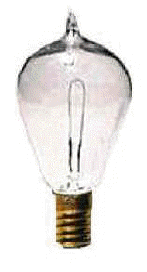
At first, these lamps were
offered in clear glass, but colored lights soon followed with the
introduction of red and green. Additional colors followed a bit later,
including blue, amber, yellow, purple (rare) and milk glass. The collector
can find these lamps that were made in the United States, as well as
German and Japanese examples.
After about 1907, miniature
Christmas lamps were made with a black glass insulator at the tip of the
base, and the vast majority for Christmas use were originating from Japan. The white paper
candlepower rating on the glass envelopes was left off, and the country of
origin was stamped into the brass base of the lamps. In addition to clear
glass, there are many color
variations of these lamps available to the collector, and they are pictured
below. The least common colors are the amber and yellow, and the purple
color is exceedingly rare. Lamps
like this continued to be made until about 1920 or so. The collector will
typically find that American and German made colored lamps from this
period are painted, while their Japanese counterparts are true colored
glass.
Beginning in 1916, General
Electric, the leading lamp manufacturer in the world, was selling their
Christmas lamps with the new tungsten filament technology. Tungsten was a
superior filament material, as it had none of the uneven burning
disadvantages of carbon, and used far less current as well. The light
output was whiter and brighter, and the filaments were cheaper to make.
The envelope shape of the lamp was changing as well, as the manufacturing
process would soon allow the delicate exhaust tip of the lamps to be
hidden in the base where it would not be so easily damaged. The lamps were
now round, and were technically referred to as a G-8 or G-9. The "G" stood
for a globular shape, and the "8" or "9" stood for the size: 8/8th or
9/8th of an inch in diameter. See the Frequently Asked Questions section
of this site for a more complete explanation of Christmas lamp sizes. Here
is the breakdown of the evolution of the General Electric tungsten
filament Christmas lamp:
|
General Electric Series-Type Tungsten Filament Christmas Lamp Evolution |
|
1913 |
As early as
this year, some small light bulb manufacturers (but not General
Electric) were offering specialty tungsten filament 14 volt lamps
for Christmas Tree decorating use. The lamps were quite expensive
and not commonly used. |
| 1916 |
First common use of tungsten for
Christmas lamp filaments, round and with an exhaust tip. No
markings, or simply MAZDA 14V stamped into the brass base.
|
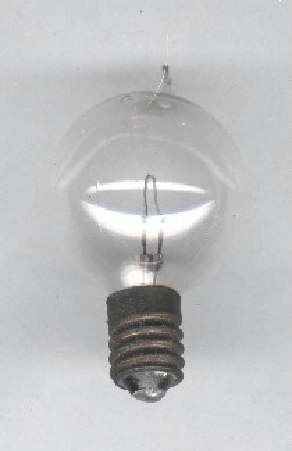 |
| 1918 |
Tipless round tungsten
filament Christmas lamps introduced. Same markings as above.
|
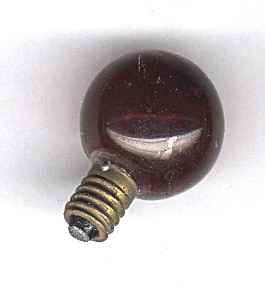 |
| 1919 |
The first smooth cone
shaped lamps were sold, designed to imitate the shape of a candle
flame. Markings on the lamps were in large letters around the glass
envelope and read: "G-E MAZDA MADE IN USA." |
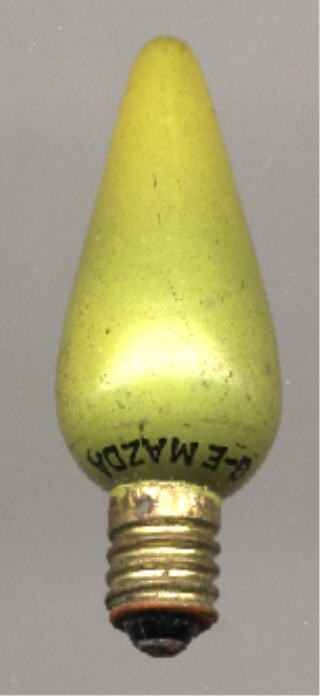 |
| 1922 |
Fluted cone lamps
introduced. Flutes are at an angle to each other and are shallowly
molded. The GE marking on the glass reads: "G-E MAZDA MADE IN
USA". Pictured here is the "Snow Tip" paint variation. |
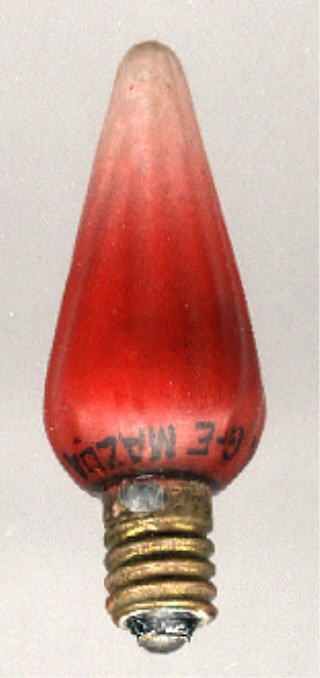 |
| 1923 |
The straight fluted cones
make their first appearance. Glass envelope size is a C-6 1/2.
Markings read: "GE MAZDA MADE IN USA". |
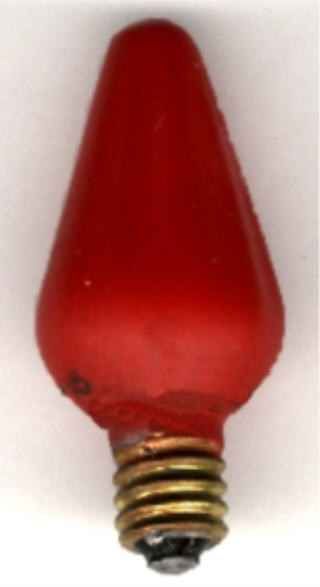 |
| 1924 |
The smaller, true C-6
cones are introduced. Straight fluted, these lamps remained in
production, virtually unchanged except for paint, until the 1970s. |
 |
| 1932 |
The Mazda Detector lamp
is introduced, and was sold for a period of about six years. Filled
with a neon gas, it would glow when burned out, enabling the owner
to quickly locate the failed lamp on a darkened tree. Note the clear
bottom to enable the user to see the glowing gas. |
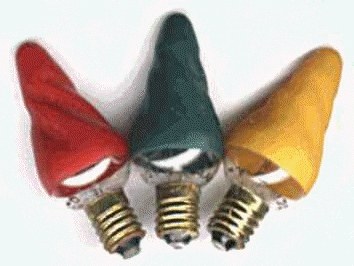 |
| 1932 |
C-6 straight sided cone
logo changes to a "stacked style":
G-E
MAZDA
USA |
 |
| 1945 |
After World
War II, General Electric discontinues the use of the MAZDA name on
their lamps. |
| 1949 |
General Electric switches
from flat paint to a semi-gloss paint for their lamps. The colors
are not as dark and rich as on the flat examples. The logo on the
lamps reads simply "G-E" |
 |
| 1957 |
General Electric switches
to a high gloss paint, and now uses aluminum rather than brass for
their base material. |
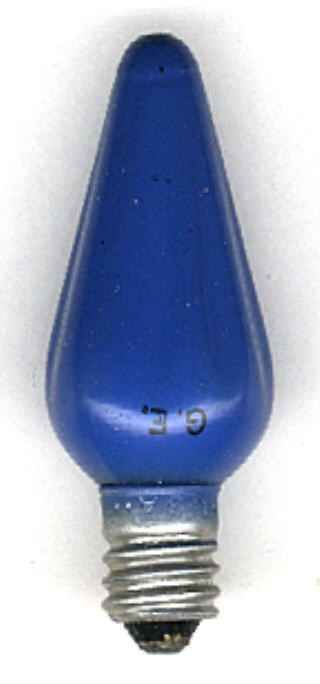 |
| 1959 |
The logo on the GE lamps
changes to the famous "script in a circle" style, sometimes referred
to by collectors as the "meatball logo". |
 |
| 1974 |
The last year for the
production of General Electric "C-6" lamps. |
| Another way
of dating many of the old lamps and outfits from various
manufacturers is by looking at the voltage rating information for
the item. In the United States, voltage requirements and ratings
changed over the years, and this information can be quite useful in
assigning an approximate date of manufacture to your vintage
electrical item. Here is a breakdown of the various voltages and
time periods: |
|
DATE |
VOLTAGE RATING AND
INFORMATION |
1905
to
1917 |
In the
earliest days of electricity, Thomas Edison's electric companies
used a voltage rating (or "pressure") of 100-110 volts,
direct current. The actual voltage delivered to
his customers varied within that range, due to direct current's
tendencies to drop voltages in long runs. Toward the end of this
period, Edison standardized his power distribution at 110/220 volts.
Although some carbon filament lamps will have a voltage rating of
16 to extend their life, most lamps and outfits from this
era will read:
|
LAMP TYPE |
LAMP WILL SAY: |
OUTFIT WILL SAY: |
|
For use
in series-wired outfits |
14V |
For use
on systems supplying 100-110 volts |
|
For use
in parallel-wired outfits |
110 V |
For use
on systems supplying 110 volts |
|
1917
to
1932 |
This time
period saw the switchover to the use of 115 volts alternating current,
which did not have the problem of losing voltage "pressure" while
traveling over long distances. Although the voltage rating had
increased by 5 volts, lamps intended for use in series-wired strings
did not always have their voltage ratings increased. Lamps and
outfits made during this time will usually read:
|
LAMP TYPE |
LAMP WILL SAY |
OUTFIT WILL SAY |
|
For use
in series-wired outfits |
14V or
15V |
For use
on systems supplying 100-115 volts AC or DC |
|
For use
in parallel-wired outfits |
115V |
For use
on systems supplying 115 volts |
|
1933
to
Present |
It was
during this time that the 120 volt alternating current system that
we still
use today was adopted. All of the lamps intended for series wired
use had
voltage ratings of 15 or 16.
|
LAMP TYPE |
LAMP WILL SAY |
OUTFIT WILL SAY |
|
For use
in series-wired outfits |
15V |
For use
on 110-120 volt circuits |
|
Extended life lamps for use in series wired outfits |
16V |
For use
on 110-120 volt circuits |
|
For use
in parallel-wired outfits |
120V |
For use
on 110-120 volt circuits |
|
Additional information for
this page has kindly been provided by Rick Delair. This collector
sincerely
appreciates his kind assistance and willingness to share information.
Welcome Page
TABLE OF CONTENTS
|

































